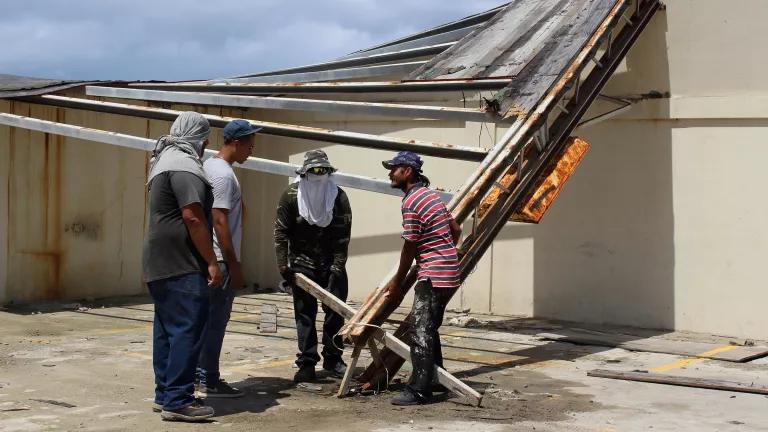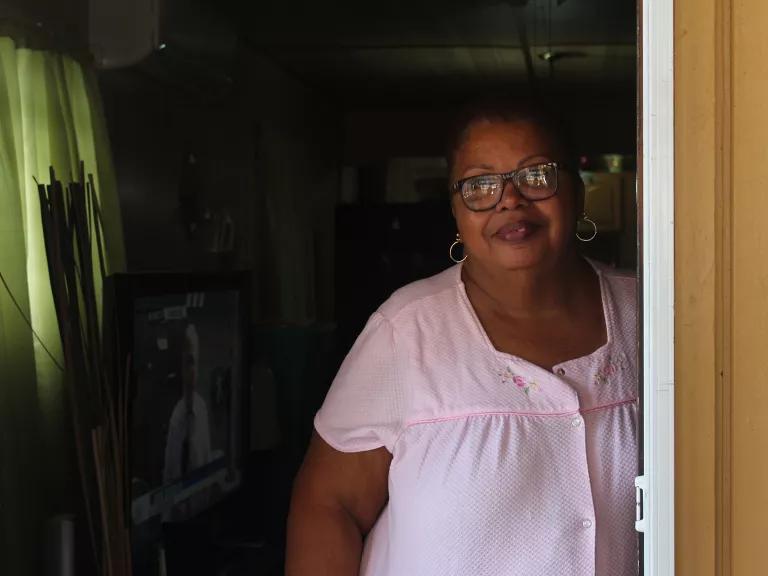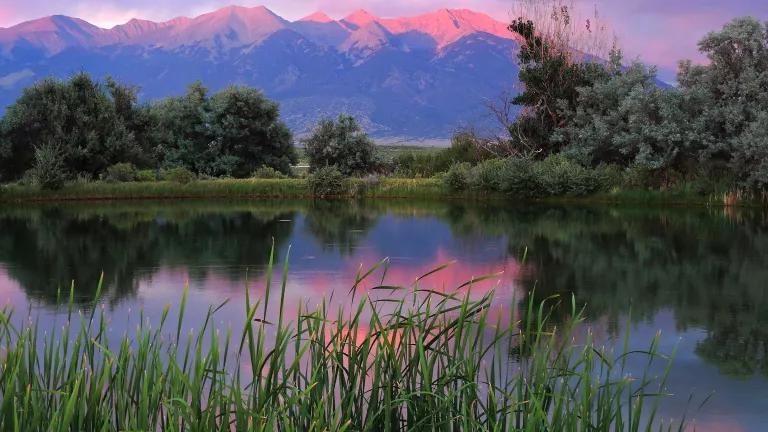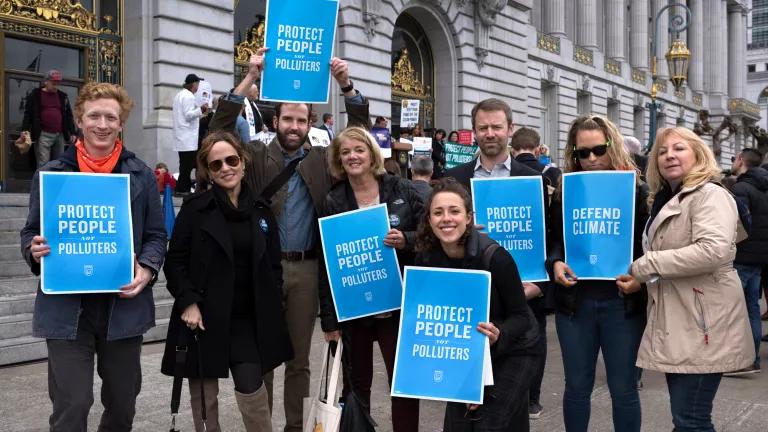Six Months After Maria: Puerto Rico's Growing Health Crisis
Since the deadly hurricane, there have been increases in incidences of cardiac arrests, higher rates of waterborne disease, mushrooming suicides, and shortage of medical equipment and staff.

Six months after Maria, Puerto Rico struggles to rebuild.
Mekela Panditharatne/NRDC
Six months after Hurricane Maria struck Puerto Rico, the island is struggling to rebuild. Under the cover of a balmy spring, a healthcare crisis is brewing. Earlier this month in San Juan, I spoke to Dr. Wendy Matos, executive director of the University of Puerto Rico’s faculty practice plan, where she supervises nearly 470 doctors across the island. What she described was stunning: patient attrition in the tens of thousands, increases in incidences of cardiac arrests and intracranial hemorrhages, higher rates of waterborne disease, mushrooming suicides, and medical equipment and staff shortages. Better data collection and more federal aid is needed by Puerto Rico's health sector to prevent more disaster-related deaths and illnesses.
The following is her testimony.
Dr. Matos: My name is Dr. Wendy Matos, PhD, MPHE. I am the Executive Director of the Faculty Practice Plan for the University of Puerto Rico Medical Sciences Campus. I oversee 468 physicians working at 29 sites across Puerto Rico, covering 91 specialty groups. The doctors I oversee comprise the largest network of medical specialists and sub-specialists in Puerto Rico.
The patients my doctors see are typically those with complex conditions or who are very sick—that is, high cost and high need patients. We administer ambulatory (outpatient) clinics, and provide specialty and sub-specialty services to patients in Puerto Rico. We also provide inpatient institutional services to people admitted to eight specialty hospitals that comprise the Puerto Rico Medical Center.
The majority—65 percent—of our patient population is medically indigent. Although most of our patients are covered by government health plan coverage, we receive very low payment, or no payment at all, for our medical services.
Hurricane Maria dramatically affected health, mortality and access to care in Puerto Rico. Since Maria, we have lost track of tens of thousands of patients. Today, we are seeing around 25 percent fewer patients at our hospitals since Hurricane Maria struck the island, when comparing 4 months of data from September 1 to December 31, 2016 (117,156 patients), to September 1, 2017 to December 31, 2017 (90,475 patients). The number of babies presenting for treatment at our natal services has dropped by around 50 percent.
The Health Problems We Are Seeing in Our Patient Population After Maria Are Severe
The top in-patient service my doctors currently provide at one of our facilities is for patients with intracranial hemorrhages—a type of bleeding within the skull that sometimes causes strokes. The top health problems my physicians are seeing in our patient population after Hurricane Maria also include: Diabetes mellitus type 1 with ketoacidosis; cardiac arrests; gastroenteritis; dermatological conditions—dermatitis, psoriasis, and scabies; musculoskeletal conditions; and respiratory conditions such as asthma and allergies. Each of these medical conditions has seen an increase of at least 10 percent in our patient population after the hurricane.
The most frequent symptoms bringing patients to our clinics are those that are stress related, specially impacting pregnant women, as well as cardiac patients and people needing pain management. Infectious diseases numbers from February and March 2018 remain higher since the disaster.
Our patients still lack access to potable water. Even now, they are presenting with illnesses related to drinking water contamination at greater rates than doctors were seeing prior to Hurricane Maria. These diseases include gastroenteritis, conjunctivitis, and dermatological conditions such as dermatitis, scabies and pediculosis. Some of our patients have tested positive for shigellosis. Since Maria, we have also seen several cases of leptospirosis—a relatively rare bacterial infection in humans, commonly transmitted by allowing fresh water that has been contaminated by animal urine (often from rats) to come in contact with the skin, eyes, or with the mucous membranes. This condition usually causes heart failure, kidney failure or liver failure, and most sufferers die if they are not treated quickly. Waterborne diseases are still present as a significant health risk to our patients six months after Maria.
Mental health issues are extreme. My doctors are seeing a significant increase in suicides, and suicide attempts, after the hurricane. The elderly population is suffering the most. Elderly patients presenting at our clinics are extremely anxious and depressed. Many have psychosomatic symptoms related to high levels of stress such as: palpitations, angina, shortness of breath, insomnia, lack of appetite, anxiety, and depression.
Access to Healthcare Is a Problem in Puerto Rico Post-Maria
At present, there is a serious problem with lack of access to healthcare in Puerto Rico. Many residents need doctors, but cannot travel to San Juan from more remote areas because they don’t have cars. Roads and transportation are ill-repaired and inaccessible, in many cases. In my opinion, recovery efforts need to focus on rehabilitation and reconstructing medical facilities, and on helping physicians who are in more remote communities to start up their practices again.
Privately owned clinics—as opposed to federally qualified medical centers—have been particularly badly affected by Maria. Most medical services in Puerto Rico are privately owned. After Maria, the Puerto Rican government contracted with insurance companies to manage health plans; these companies were affected by the disaster and stopped paying medical care providers. This has prevented many medical clinics from re-opening after the hurricane. I am carrying $12 million in arrears with respect to my own clinics, because I am not currently receiving payment from the insurance companies contracted by the government.
Many healthcare providers are leaving the island. There was a serious shortage of specialists in Puerto Rico before Maria; this situation has been worsened by the hurricane. The severe specialist and health care professional shortage puts a heavy strain on my clinics. Patients who should ordinarily be seeing primary healthcare providers are turning up at my clinics in greater numbers than before.
Pregnant Women and Infants Face Unique Risks
A number of pregnant women identified as high risk were sent to the mainland to receive obstetric and birthing services when the hurricane hit. Babies that were expected to be born with congenital cardiac diseases were specially affected because the referral hospital was not able to provide the necessary care.
During Hurricane Maria, the Neonatal Intensive Care Unit (NICU) at the University Pediatric Hospital was relocated. Neonatologists relocated NICU patients in other hospital areas to provide the level 4 services that patients needed after the emergency. This resulted in an increase in nosocomial infections (infections originating in-hospital) because, although hand cleaning and other sanitation protocols were enforced, the environment was not suitable for newborns.
Municipalities Outside San Juan Were Slow to Receive Any Functioning Medical Services After Maria
In the immediate aftermath of Maria, clinicians and students from the University of Puerto Rico Medical Sciences Campus were the first responders in providing medical services to residents in 58 municipalities, at the invitation of the governor of Puerto Rico. These included the remote communities of Vieques and Culebra. What we were seeing in these municipalities were chronic patients who were left for several days, without insulin in some cases, without prescription medicines, and without food and water. There was, and still is, an inadequate response to the health needs of Puerto Ricans after Maria.
Government Data Collection on Health is Not Occurring or Inadequate
There is a growing healthcare crisis on the island. The disaster was at such a scale that it impacted all government agencies, and affected data collection and statistics about the incidence of disease and other health risks. This is, in part, because available resources are strained. In my view disease rates, injuries and deaths are being underreported.
Healthcare Providers and Clinics Have Significant Resource Needs
Like medical facilities across Puerto Rico, the clinics I oversee are facing critical resource issues. After the hurricane, we couldn’t perform MRIs and ambulatory (outpatient) surgeries because power generators weren’t sufficient to support these tasks. What we really need is solar power so that we can remain functioning at a high level during an emergency power outage.
We also need information technology equipment to perform telemedicine, health education, as well as medical equipment to enhance our prevention and screening services for vulnerable residents who cannot travel to our clinics. Urodynamic equipment for urethra and bladder assessment and hysteroscopy equipment would greatly aid our patients and health clinics.
After Maria, we acknowledged the need to increase our participation in outreach activities, and to provide integrated and comprehensive services to those that need it most.
Both Specialists and Primary Care Providers Need Support After Maria
As described by the Institute of Medicine, providing safe, effective, patient-centered, timely, efficient and equitable services is our mission at all our clinics. In treating people with complex conditions, we strive to increase quality of care, contain costs and reduce patient complications.

Patients still lack access to care.
Mekela Panditharatne/NRDC
But we need a lot more help. In my opinion, there is an urgent need to provide comprehensive and integrated care to residents of Puerto Rico, and to support Puerto Rico’s primary care physicians. If doctors serving people living outside the metro areas of Puerto Rico receive more support from our specialists, there will be better guidance, preventive services and less patient complications for people with complex health conditions on the island.


